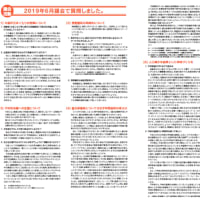【盗用学位論文】
小保方の博士論文の冒頭の「序論」が、そっくりNIH広報<STEM CELL BASICS>という文章からの盗用であることが確定した。NIHの広報文はここにある。
http://stemcells.nih.gov/info/basics/pages/basics1.aspx
以下は論文冒頭から8パラグラフについて、小保方学位論文とNIH広報記事を比較対照したもの。
学位論文をネットにアップした人たち、盗用を指摘した人たちに感謝したい。
詳細はここを参照されたい。
http://stapcells.blogspot.jp/2014/02/blog-post_2064.html
全体で108頁ちょっとある大論文だが、冒頭の「Gneneral Introduction」26ページ文はそっくりNIHの文章から盗用されている。これはネイチャー第1論文における、10行200余語の他論文盗用どころではない。あまりにも膨大なのでそれ以上チェックする意欲を失った。
盗用や捏造を「出来心でやった」というのは本人の弁明で、実際はずうっと前からやってい この事件は事柄の重要性、捏造の性質において2001年に明るみに出たベル研究所の、「高温超伝導」に関するシェーン事件に匹敵する、科学史に残る事件だろう。
これで早稲田大学は博士号剥脱をやらざるをえないだろう。そうでないと世論が収まるまい。
それにしても不思議なのは、学位論文審査員はこれが論文の冒頭に来る「序論(イントロダクション)」(研究の背景説明)でなく、一般市民に「幹細胞研究」を紹介する解説文だということに気づかなかったのだろうか?
審査員には
早稲田大学教授:常田聡
同: 武岡真司
東京女子医大教授:大和雅之
ハーヴァード大教授:Chrles A. Vacanti
が名前を連ねている。ここに指摘されているような、引用論文リストの番号が本文に一つも出て来ない論文など聞いたことがない。
http://stapcells.blogspot.jp/2014/02/blog-post_2064.html
審査員はどうしてその不自然さに気づかなかったのであろうか?
小保方学位論文には、コピーしたこなれた文章と自分で書いた高校生に毛が生えた程度の目茶苦茶な文章とが、パラグラフ単位で混在している。いわば専門技術論文の中に、新聞記事が混在したような論文だ。
この文には掲げた範囲で「科学者(Scientist)」という用語が8回も出てくる。新聞記者ではないのだから、自分の研究の立ち位置を説明する場合には先行する研究者のことを「研究者(Investigator or Researcher)」というのが普通で、自分も含めScientistsとは呼ばない。
この「Scientist」という表現が「外在的」な表現であり、自分がやった学位論文のための研究にこういう用語が使用されていることに、審査員は違和感をいだくべきであったと思う。
(小保方の英文のうち、黒字のものは、私のカット&ペーストで出て来たもの。NIHの文章ではこの現象が起こらず、理由不明。)
これまでGOOGLE検索は単語を検索するものと思いこんでいたが、試みに<they serve as a sort of internal repair system, dividing essentially without limit to replenish other cells as long as the person or animal is still alive.>という<小保方博士論文1>にある長い、それでいてやや個性的な文章を入力して検索したら、一発で<NIH広報記事1>が出て来た。
なるほどこれで「盗用検出」ができるわけか、と思った。3/7のメルマガで取り上げた、E.ワグナー女史の様なプロの科学誌編集者が「盗用検出ソフト」を用いて、論文に含まれる盗用を検出しているというのが、実感としてよくわかった。
それと学位論文の「序論」部分は、そのテーマに関する過去の研究を総括して、自分の研究の意義とそれが解決する問題を浮き彫りにするためにあるので、その分野の画期的な重要論文を上手く引用する能力が試される。しかし、小保方学位論文には、NIH広報記事をそのままコピーしているので、引用論文が一切ない。
これもきわめて不自然で、論文審査者はそのことに気づくべきであった。
ネットでは「序論におけるコピーは引用論文を増やさないためにも許される」という生物系の大学研究者の意見もあるが、もってのほかだ。引用文献の数を増やさないためなら、すぐれた総説を1本引用すればすむことだ。慣用的表現が偶然に一致した場合を除き、盗用は絶対許されない。その意味で、NIH文書から70行もコピーしている小保方学位論文は完全にアウトである。
<小保方博士論文1>
1.1 General Introduction
• Importance of stem cells
Stem cells have the remarkable potential to develop into many different cell types in the body during early life and growth. In addition, in many tissues they serve as a sort of internal repair system, dividing essentially without limit to replenish other cells as long as the person or animal is stiH alive.
When a stem cell divides, each new cell has the potential either to remain a stem cell or become another type of cell with a more specialized function, such as a muscle cell, a red blood cell, or a brain ceU.
<NIH広報記事1>
I. Introduction: What are stem cells, and why are they important?
Stem cells have the remarkable potential to develop into many different cell types in the body during early life and growth. In addition, in many tissues they serve as a sort of internal repair system, dividing essentially without limit to replenish other cells as long as the person or animal is still alive.
When a stem cell divides, each new cell has the potential either to remain a stem cell or become another type of cell with a more specialized function, such as a muscle cell, a red blood cell, or a brain cell.
<小保方博士論文2>
Stem cells are distinguished from other cell types by two important characteristics.
First, they are unspeciaHzed cells capable of renewing themselves through cell
division, sometimes after long periods of inactivity. Second, under certain
physiologic or experimental conditions, they can be induced to become tissue- or
organ-specific cells with special functions.
In some organs, such as the gut and bone marrow, stem cells regularly divide to repair and replace worn out or damaged tissues. In other organs, however, such as the pancreas and the heart, stem cells only divide under special conditions.
<NIH広報記事2>
Stem cells are distinguished from other cell types by two important characteristics.
First, they are unspecialized cells capable of renewing themselves through cell division, sometimes after long periods of inactivity.
Second, under certain physiologic or experimental conditions, they can be induced to become tissue- or organ-specific cells with special functions.
In some organs, such as the gut and bone marrow, stem cells regularly divide to repair and replace worn out or damaged tissues. In other organs, however, such as the pancreas and the heart, stem cells only divide under special conditions.
<小保方博士論文3>
Until recently, scientists primarily worked with two kinds of stem cells from animals and humans^ embryonic stem cells and non-embryonic "somatic" or "adult"stem ceUs. The functions and characteristics of these ceUs will be explained in this section.
Scientists discovered ways to derive embryonic stem cells from early mouse
embryos nearly 30 years ago, in 1981.
The detailed study of the biology of mouse stem ceUs led to the discovery, in 1998, of a method to derive stem ceUs from human embryos and grow the cells in the laboratory. These cells are called human embryonic stem cells. The embryos used in these studies were created for reproductive purposes through in vitro fertilization procedures.
When they were no longer needed for that purpose, they were donated for research with the informed consent of the donor.
In 2006, researchers made another breakthrough by identifying conditions that would allow some specialized adult cells to be "reprogrammed" genetically to assume a stem cell-like state.
This new type of stem cell, called induced pluripotent stem cells (iPSCs), will be discussed in a later part of this section.
<NIH広報記事3>
Until recently, scientists primarily worked with two kinds of stem cells from animals and humans: embryonic stem cells and non-embryonic "somatic" or "adult" stem cells. The functions and characteristics of these cells will be explained in this document.
Scientists discovered ways to derive embryonic stem cells from early mouse embryos nearly 30 years ago, in 1981.
The detailed study of the biology of mouse stem cells led to the discovery, in 1998, of a method to derive stem cells from human embryos and grow the cells in the laboratory. These cells are called human embryonic stem cells. The embryos used in these studies were created for reproductive purposes through in vitro fertilization procedures.
When they were no longer needed for that purpose, they were donated for research with the informed consent of the donor.
In 2006, researchers made another breakthrough by identifying conditions that would allow some specialized adult cells to be "reprogrammed" genetically to assume a stem cell-like state.
This new type of stem cell, called induced pluripotent stem cells (iPSCs), will be discussed in a later section of this document.
<小保方学位論文4>
Stem ceUs are important for hving organisms for many reasons. In the 3* to 5-day-old embryo, called a blastocyst, the inner cells give rise to the entire body of the organism, including all of the many specialized cell types and organs such as the heart, lung, skin, sperm, eggs and other tissues.
In some adult tissues, such as bone marrow, muscle, and brain, discrete populations of adult stem cells generate replacements for cells that are lost through normal wear and tear, injury, or disease.
<NIH広報記事4>
Stem cells are important for living organisms for many reasons. In the 3- to 5-day-old embryo, called a blastocyst, the inner cells give rise to the entire body of the organism, including all of the many specialized cell types and organs such as the heart, lung, skin, sperm, eggs and other tissues.
In some adult tissues, such as bone marrow, muscle, and brain, discrete populations of adult stem cells generate replacements for cells that are lost through normal wear and tear, injury, or disease.
<小保方学位論文5>
Given their unique regenerative abilities, stem cells offer new potentials for treating diseases such as diabetes, and heart disease. However, much work remains to be done in the laboratory and the clinic to understand how to use these cells for cell-based therapies to treat disease, which is also referred to as regenerative or reparative medicine.
Laboratory studies of stem cells enable scientists to learn about the cells' essential properties and what makes them different from specialized cell types. Scientists are already using stem cells in the laboratory to screen new drugs and to develop model systems to study normal growth and identify the causes of birth defects.
Research on stem cells continues to advance knowledge about how an organism develops from a single cell and how healthy cells replace damaged cells in adult organisms. Stem cell research is one of the most fascinating areas of contemporary biology, but, as with many expanding fields of scientific inquiry, research on stem cells raises scientific questions as rapidly as it generates new discoveries.
<NIH広報記事5>
Given their unique regenerative abilities, stem cells offer new potentials for treating diseases such as diabetes, and heart disease. However, much work remains to be done in the laboratory and the clinic to understand how to use these cells for cellbased therapies to treat disease, which is also referred to as regenerative or reparative medicine.
Laboratory studies of stem cells enable scientists to learn about the cells’ essential properties and what makes them different from specialized cell types. Scientists are already using stem cells in the laboratory to screen new drugs and to develop model
systems to study normal growth and identify the causes of birth defects.
Research on stem cells continues to advance knowledge about how an organism develops from a single cell and how healthy cells replace damaged cells in adult organisms. Stem cell research is one of the most fascinating areas of contemporary biology, but, as with many expanding fields of scientific inquiry, research on stem cells raises scientific questions as rapidly as it generates new discoveries.
<小保方学位論文6>
• The unique properties of all stem cells
Stem cells differ from other kinds of cells in the body. All stem cells―^regardless of
their source―^have three general properties^ they are capable of dividing and renewing themselves for long periods," they are unspecialized; and they can give rise to specialized cell types.
Stem cells are capable of dividing and renewing themselves for long periods. Unlike muscle cells, blood cells, or nerve cells―^which do not normally replicate themselves―stem cells may replicate many times, or proliferate.
A starting population of stem cells that proHferates for many months in the laboratory can yield milHons of cells. If the resulting cells continue to be unspecialized, like the
parent stem cells, the cells are said to be capable of long-term self-renewal.
<NIH広報記事6>
<II. What are the unique properties of all stem cells?
Stem cells differ from other kinds of cells in the body. All stem cells―regardless of their source―have three general properties: they are capable of dividing and renewing themselves for long periods; they are unspecialized; and they can give rise to specialized cell types.
Stem cells are capable of dividing and renewing themselves for long periods. Unlike muscle cells, blood cells, or nerve cells―which do not normally replicate themselves―stem cells may replicate many times, or proliferate.
A starting population of stem cells that proliferates for many months in the laboratory can yield millions of cells. If the resulting cells continue to be unspecialized, like the parent stem cells, the cells are said to be capable of long-term self-renewal.
<小保方学位論文7>
Scientists are trying to understand two fundamental properties of stem cells that
relate to their long-term self-renewal:
why can embryonic stem cells proliferate for a year or more in the laboratory
without differentiating, but most non-embryonic stem cells cannot;
and what are the factors in hving organisms that normally regulate stem cell proHferation and
self-renewal?
Discovering the answers to these questions may make it possible to understand how
cell proliferation is regulated during normal embryonic development or during the
abnormal cell division that leads to cancer.
Such information would also enable scientists to grow embryonic and non-embryonic stem cells more efficiently in the laboratory.
<NIH広報記事7>
Scientists are trying to understand two fundamental properties of stem cells that relate to their long-term self-renewal:
1. why can embryonic stem cells proliferate for a year or more in the laboratory without differentiating, but most non-embryonic stem cells cannot; and
2. what are the factors in living organisms that normally regulate stem cell proliferation and self-renewal?
Discovering the answers to these questions may make it possible to understand how cell proliferation is regulated during normal embryonic development or during the abnormal cell division that leads to cancer.
Such information would also enable scientists to grow embryonic and non-embryonic stem cells more efficiently in the laboratory.
<小保方学位論文8>
The specijSc factors and conditions that allow stem cells to remain unspeciaHzed are of great interest to scientists. It has taken scientists many years of trial and error to learn to derive and maintain stem cells in the laboratory without them spontaneously differentiating into specific cell tj^es.
For example, it took two decades to learn how to grow human embryonic stem cells in the laboratory following the development of conditions for growing mouse stem cells.
Therefore, understanding the signals in a mature organism that cause a stem cell population to prohferate and remain unspecialized until the cells are needed. Such information is critical for scientists to be able to grow large numbers of unspecialized stem cells in the laboratory for further experimentation.
<NIH広報記事8>
The specific factors and conditions that allow stem cells to remain unspecialized are of great interest to scientists. It has taken scientists many years of trial and error to learn to derive and maintain stem cells in the laboratory without them spontaneously differentiating into specific cell types.
For example, it took two decades to learn how to grow human embryonic stem cells in the laboratory following the development of conditions for growing mouse stem cells.
Therefore, understanding the signals in a mature organism that cause a stem cell population to proliferate and remain unspecialized until the cells are needed. Such information is critical for scientists to be able to grow large numbers of unspecialized stem cells in the laboratory for further experimentation.
小保方の博士論文の冒頭の「序論」が、そっくりNIH広報<STEM CELL BASICS>という文章からの盗用であることが確定した。NIHの広報文はここにある。
http://stemcells.nih.gov/info/basics/pages/basics1.aspx
以下は論文冒頭から8パラグラフについて、小保方学位論文とNIH広報記事を比較対照したもの。
学位論文をネットにアップした人たち、盗用を指摘した人たちに感謝したい。
詳細はここを参照されたい。
http://stapcells.blogspot.jp/2014/02/blog-post_2064.html
全体で108頁ちょっとある大論文だが、冒頭の「Gneneral Introduction」26ページ文はそっくりNIHの文章から盗用されている。これはネイチャー第1論文における、10行200余語の他論文盗用どころではない。あまりにも膨大なのでそれ以上チェックする意欲を失った。
盗用や捏造を「出来心でやった」というのは本人の弁明で、実際はずうっと前からやってい この事件は事柄の重要性、捏造の性質において2001年に明るみに出たベル研究所の、「高温超伝導」に関するシェーン事件に匹敵する、科学史に残る事件だろう。
これで早稲田大学は博士号剥脱をやらざるをえないだろう。そうでないと世論が収まるまい。
それにしても不思議なのは、学位論文審査員はこれが論文の冒頭に来る「序論(イントロダクション)」(研究の背景説明)でなく、一般市民に「幹細胞研究」を紹介する解説文だということに気づかなかったのだろうか?
審査員には
早稲田大学教授:常田聡
同: 武岡真司
東京女子医大教授:大和雅之
ハーヴァード大教授:Chrles A. Vacanti
が名前を連ねている。ここに指摘されているような、引用論文リストの番号が本文に一つも出て来ない論文など聞いたことがない。
http://stapcells.blogspot.jp/2014/02/blog-post_2064.html
審査員はどうしてその不自然さに気づかなかったのであろうか?
小保方学位論文には、コピーしたこなれた文章と自分で書いた高校生に毛が生えた程度の目茶苦茶な文章とが、パラグラフ単位で混在している。いわば専門技術論文の中に、新聞記事が混在したような論文だ。
この文には掲げた範囲で「科学者(Scientist)」という用語が8回も出てくる。新聞記者ではないのだから、自分の研究の立ち位置を説明する場合には先行する研究者のことを「研究者(Investigator or Researcher)」というのが普通で、自分も含めScientistsとは呼ばない。
この「Scientist」という表現が「外在的」な表現であり、自分がやった学位論文のための研究にこういう用語が使用されていることに、審査員は違和感をいだくべきであったと思う。
(小保方の英文のうち、黒字のものは、私のカット&ペーストで出て来たもの。NIHの文章ではこの現象が起こらず、理由不明。)
これまでGOOGLE検索は単語を検索するものと思いこんでいたが、試みに<they serve as a sort of internal repair system, dividing essentially without limit to replenish other cells as long as the person or animal is still alive.>という<小保方博士論文1>にある長い、それでいてやや個性的な文章を入力して検索したら、一発で<NIH広報記事1>が出て来た。
なるほどこれで「盗用検出」ができるわけか、と思った。3/7のメルマガで取り上げた、E.ワグナー女史の様なプロの科学誌編集者が「盗用検出ソフト」を用いて、論文に含まれる盗用を検出しているというのが、実感としてよくわかった。
それと学位論文の「序論」部分は、そのテーマに関する過去の研究を総括して、自分の研究の意義とそれが解決する問題を浮き彫りにするためにあるので、その分野の画期的な重要論文を上手く引用する能力が試される。しかし、小保方学位論文には、NIH広報記事をそのままコピーしているので、引用論文が一切ない。
これもきわめて不自然で、論文審査者はそのことに気づくべきであった。
ネットでは「序論におけるコピーは引用論文を増やさないためにも許される」という生物系の大学研究者の意見もあるが、もってのほかだ。引用文献の数を増やさないためなら、すぐれた総説を1本引用すればすむことだ。慣用的表現が偶然に一致した場合を除き、盗用は絶対許されない。その意味で、NIH文書から70行もコピーしている小保方学位論文は完全にアウトである。
<小保方博士論文1>
1.1 General Introduction
• Importance of stem cells
Stem cells have the remarkable potential to develop into many different cell types in the body during early life and growth. In addition, in many tissues they serve as a sort of internal repair system, dividing essentially without limit to replenish other cells as long as the person or animal is stiH alive.
When a stem cell divides, each new cell has the potential either to remain a stem cell or become another type of cell with a more specialized function, such as a muscle cell, a red blood cell, or a brain ceU.
<NIH広報記事1>
I. Introduction: What are stem cells, and why are they important?
Stem cells have the remarkable potential to develop into many different cell types in the body during early life and growth. In addition, in many tissues they serve as a sort of internal repair system, dividing essentially without limit to replenish other cells as long as the person or animal is still alive.
When a stem cell divides, each new cell has the potential either to remain a stem cell or become another type of cell with a more specialized function, such as a muscle cell, a red blood cell, or a brain cell.
<小保方博士論文2>
Stem cells are distinguished from other cell types by two important characteristics.
First, they are unspeciaHzed cells capable of renewing themselves through cell
division, sometimes after long periods of inactivity. Second, under certain
physiologic or experimental conditions, they can be induced to become tissue- or
organ-specific cells with special functions.
In some organs, such as the gut and bone marrow, stem cells regularly divide to repair and replace worn out or damaged tissues. In other organs, however, such as the pancreas and the heart, stem cells only divide under special conditions.
<NIH広報記事2>
Stem cells are distinguished from other cell types by two important characteristics.
First, they are unspecialized cells capable of renewing themselves through cell division, sometimes after long periods of inactivity.
Second, under certain physiologic or experimental conditions, they can be induced to become tissue- or organ-specific cells with special functions.
In some organs, such as the gut and bone marrow, stem cells regularly divide to repair and replace worn out or damaged tissues. In other organs, however, such as the pancreas and the heart, stem cells only divide under special conditions.
<小保方博士論文3>
Until recently, scientists primarily worked with two kinds of stem cells from animals and humans^ embryonic stem cells and non-embryonic "somatic" or "adult"stem ceUs. The functions and characteristics of these ceUs will be explained in this section.
Scientists discovered ways to derive embryonic stem cells from early mouse
embryos nearly 30 years ago, in 1981.
The detailed study of the biology of mouse stem ceUs led to the discovery, in 1998, of a method to derive stem ceUs from human embryos and grow the cells in the laboratory. These cells are called human embryonic stem cells. The embryos used in these studies were created for reproductive purposes through in vitro fertilization procedures.
When they were no longer needed for that purpose, they were donated for research with the informed consent of the donor.
In 2006, researchers made another breakthrough by identifying conditions that would allow some specialized adult cells to be "reprogrammed" genetically to assume a stem cell-like state.
This new type of stem cell, called induced pluripotent stem cells (iPSCs), will be discussed in a later part of this section.
<NIH広報記事3>
Until recently, scientists primarily worked with two kinds of stem cells from animals and humans: embryonic stem cells and non-embryonic "somatic" or "adult" stem cells. The functions and characteristics of these cells will be explained in this document.
Scientists discovered ways to derive embryonic stem cells from early mouse embryos nearly 30 years ago, in 1981.
The detailed study of the biology of mouse stem cells led to the discovery, in 1998, of a method to derive stem cells from human embryos and grow the cells in the laboratory. These cells are called human embryonic stem cells. The embryos used in these studies were created for reproductive purposes through in vitro fertilization procedures.
When they were no longer needed for that purpose, they were donated for research with the informed consent of the donor.
In 2006, researchers made another breakthrough by identifying conditions that would allow some specialized adult cells to be "reprogrammed" genetically to assume a stem cell-like state.
This new type of stem cell, called induced pluripotent stem cells (iPSCs), will be discussed in a later section of this document.
<小保方学位論文4>
Stem ceUs are important for hving organisms for many reasons. In the 3* to 5-day-old embryo, called a blastocyst, the inner cells give rise to the entire body of the organism, including all of the many specialized cell types and organs such as the heart, lung, skin, sperm, eggs and other tissues.
In some adult tissues, such as bone marrow, muscle, and brain, discrete populations of adult stem cells generate replacements for cells that are lost through normal wear and tear, injury, or disease.
<NIH広報記事4>
Stem cells are important for living organisms for many reasons. In the 3- to 5-day-old embryo, called a blastocyst, the inner cells give rise to the entire body of the organism, including all of the many specialized cell types and organs such as the heart, lung, skin, sperm, eggs and other tissues.
In some adult tissues, such as bone marrow, muscle, and brain, discrete populations of adult stem cells generate replacements for cells that are lost through normal wear and tear, injury, or disease.
<小保方学位論文5>
Given their unique regenerative abilities, stem cells offer new potentials for treating diseases such as diabetes, and heart disease. However, much work remains to be done in the laboratory and the clinic to understand how to use these cells for cell-based therapies to treat disease, which is also referred to as regenerative or reparative medicine.
Laboratory studies of stem cells enable scientists to learn about the cells' essential properties and what makes them different from specialized cell types. Scientists are already using stem cells in the laboratory to screen new drugs and to develop model systems to study normal growth and identify the causes of birth defects.
Research on stem cells continues to advance knowledge about how an organism develops from a single cell and how healthy cells replace damaged cells in adult organisms. Stem cell research is one of the most fascinating areas of contemporary biology, but, as with many expanding fields of scientific inquiry, research on stem cells raises scientific questions as rapidly as it generates new discoveries.
<NIH広報記事5>
Given their unique regenerative abilities, stem cells offer new potentials for treating diseases such as diabetes, and heart disease. However, much work remains to be done in the laboratory and the clinic to understand how to use these cells for cellbased therapies to treat disease, which is also referred to as regenerative or reparative medicine.
Laboratory studies of stem cells enable scientists to learn about the cells’ essential properties and what makes them different from specialized cell types. Scientists are already using stem cells in the laboratory to screen new drugs and to develop model
systems to study normal growth and identify the causes of birth defects.
Research on stem cells continues to advance knowledge about how an organism develops from a single cell and how healthy cells replace damaged cells in adult organisms. Stem cell research is one of the most fascinating areas of contemporary biology, but, as with many expanding fields of scientific inquiry, research on stem cells raises scientific questions as rapidly as it generates new discoveries.
<小保方学位論文6>
• The unique properties of all stem cells
Stem cells differ from other kinds of cells in the body. All stem cells―^regardless of
their source―^have three general properties^ they are capable of dividing and renewing themselves for long periods," they are unspecialized; and they can give rise to specialized cell types.
Stem cells are capable of dividing and renewing themselves for long periods. Unlike muscle cells, blood cells, or nerve cells―^which do not normally replicate themselves―stem cells may replicate many times, or proliferate.
A starting population of stem cells that proHferates for many months in the laboratory can yield milHons of cells. If the resulting cells continue to be unspecialized, like the
parent stem cells, the cells are said to be capable of long-term self-renewal.
<NIH広報記事6>
<II. What are the unique properties of all stem cells?
Stem cells differ from other kinds of cells in the body. All stem cells―regardless of their source―have three general properties: they are capable of dividing and renewing themselves for long periods; they are unspecialized; and they can give rise to specialized cell types.
Stem cells are capable of dividing and renewing themselves for long periods. Unlike muscle cells, blood cells, or nerve cells―which do not normally replicate themselves―stem cells may replicate many times, or proliferate.
A starting population of stem cells that proliferates for many months in the laboratory can yield millions of cells. If the resulting cells continue to be unspecialized, like the parent stem cells, the cells are said to be capable of long-term self-renewal.
<小保方学位論文7>
Scientists are trying to understand two fundamental properties of stem cells that
relate to their long-term self-renewal:
why can embryonic stem cells proliferate for a year or more in the laboratory
without differentiating, but most non-embryonic stem cells cannot;
and what are the factors in hving organisms that normally regulate stem cell proHferation and
self-renewal?
Discovering the answers to these questions may make it possible to understand how
cell proliferation is regulated during normal embryonic development or during the
abnormal cell division that leads to cancer.
Such information would also enable scientists to grow embryonic and non-embryonic stem cells more efficiently in the laboratory.
<NIH広報記事7>
Scientists are trying to understand two fundamental properties of stem cells that relate to their long-term self-renewal:
1. why can embryonic stem cells proliferate for a year or more in the laboratory without differentiating, but most non-embryonic stem cells cannot; and
2. what are the factors in living organisms that normally regulate stem cell proliferation and self-renewal?
Discovering the answers to these questions may make it possible to understand how cell proliferation is regulated during normal embryonic development or during the abnormal cell division that leads to cancer.
Such information would also enable scientists to grow embryonic and non-embryonic stem cells more efficiently in the laboratory.
<小保方学位論文8>
The specijSc factors and conditions that allow stem cells to remain unspeciaHzed are of great interest to scientists. It has taken scientists many years of trial and error to learn to derive and maintain stem cells in the laboratory without them spontaneously differentiating into specific cell tj^es.
For example, it took two decades to learn how to grow human embryonic stem cells in the laboratory following the development of conditions for growing mouse stem cells.
Therefore, understanding the signals in a mature organism that cause a stem cell population to prohferate and remain unspecialized until the cells are needed. Such information is critical for scientists to be able to grow large numbers of unspecialized stem cells in the laboratory for further experimentation.
<NIH広報記事8>
The specific factors and conditions that allow stem cells to remain unspecialized are of great interest to scientists. It has taken scientists many years of trial and error to learn to derive and maintain stem cells in the laboratory without them spontaneously differentiating into specific cell types.
For example, it took two decades to learn how to grow human embryonic stem cells in the laboratory following the development of conditions for growing mouse stem cells.
Therefore, understanding the signals in a mature organism that cause a stem cell population to proliferate and remain unspecialized until the cells are needed. Such information is critical for scientists to be able to grow large numbers of unspecialized stem cells in the laboratory for further experimentation.




























反社会的行為を行うなミグルせーんだよ。
富士山はこういう山だという説明部分だから問題ないのだよ。本題の論文中身なら問題だけどなーお前だってシてるだろう。
お前方程式自分で編み出したか??出来ないだろう。だから馬鹿はこういうところに書くな馬鹿